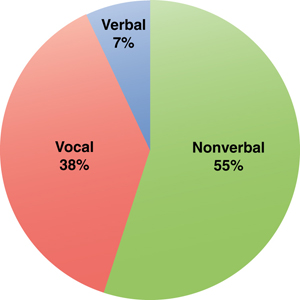Five Ways to Make Energy Real to Your Customers
Every interaction with customers is a communications opportunity. Utilities show what they value—positively and negatively—when they communicate (or not) with customers. That includes verbal communications, such as advertisements and newsletters, as well as nonverbal communications such as the availability and understandability of customer programs.
Indeed, the pie chart in Figure 1, based on research conducted by psychologist Albert Mehrabian, shows that more than 90% of the meaning in a conversation is conveyed through nonverbal means. For companies that cannot communicate individually with each of their customers, this means that actions, such as offering customers ways to lower their utility bills, count far more than the words in an ad or a press release.

1. How meaning is conveyed. Source: Egan Energy Communications
Utility communicators and marketers have a unique challenge: connecting with (mainly residential) customers about a vital service that can’t be seen, touched, tasted, or otherwise experienced—except when the lights go out.
Reach Beyond Price
Consumers in restructured markets like Texas have one way—price—to assess the relative value of electric service. Utilities inside and outside restructured markets have offered “green” electricity for years. But for utilities and their regulators, the programs are generally, if not universally, unsatisfying.
Many utilities are using—or planning to use—price as both a carrot and stick in their efforts to change the way their customers use electricity. Lower your usage, or shift usage to off-peak periods, and you could lower your electric bill. Fail to do that and your electric bill will rise.
The problem with this approach is that positioning electric service as something painful to be minimized puts utilities—and their employees—in a lose-lose situation. Option A: Do things your way and get hammered. Option B: Do things our way and get hammered somewhat less.
That’s what happens when you position your service on price for a century. But there’s another approach that offers potentially high paybacks and low costs. It involves putting the “public” back in “public service.”
Connect With Customers in Meaningful Ways
Recently, I spoke at a utility-industry conference session on “Making Energy Real.” Here are five programs that utilities are using, or could, use to demystify electric service and build bridges to their residential customers:
- Free walk-through energy audits
- In-home displays (perhaps loaned on a short-term basis)
- Direct-installation of energy-conservation measures
- Pre-pay metering
- Employee ambassador programs
Utility executives are depending on their communicators and marketers to achieve certain levels of success in various customer-facing programs like time-differentiated rates, energy efficiency, and demand response. Real dollars—often a lot of them—are at stake. Penalties too, and potentially even additional profits. At a minimum, utilities should be able to recover all of the costs of these programs, and there is a potential to include their costs in ratebase, thus boosting earnings.
Having been a utility communicator, and now an adviser to utility communicators, I know that customer interactions can be awkward or difficult. Utilities are technical, analytic, legal, and precise. They think about the long term. They are anxious about setting precedents.
Typically, customers are none of those things: They don’t know what they want—but they know they want it now. They want the services they consume to have high value. Sometimes that means low costs. Sometimes it means added features and benefits. Most times, it means convenience and customization.
The five programs listed above are all high touch, but not necessarily high cost. They focus on non-price ways to make energy real without being punitive. They invite customers to learn more about electricity and energy by meeting customers where they live—literally and figuratively. And if customers have no desire to learn about how electricity is generated, transmitted, distributed, and consumed, that’s fine too. They have a problem—high utility bills—and they want it fixed. They’ll think better of you if you can quickly address the problem so that both of you can go on your separate ways.
At the utility conference where I spoke, no attendees said their utility was offering all five programs. Some said they were offering one. Many said they were offering none of them.
Failing to develop non-price ways to connect with customers carries significant risks. It keeps utilities in the “lose-lose” proposition, vulnerable to criticism when prices increase and completely exposed to customer wrath when a once-a-century weather event turns out the lights for days at a time. Jeff Butler, former president of Connecticut Light & Power, knows all about that.
Is that a risk you want to take?
—John Egan is president of Egan Energy Communications, a utility-industry communications consulting firm in Lafayette, Colorado. Before launching EEC in 2009, Egan was a research director at E Source, a marketing analyst at Salt River Project (SRP), the head spokesman at SRP, and a reporter and editor at The Energy Daily.